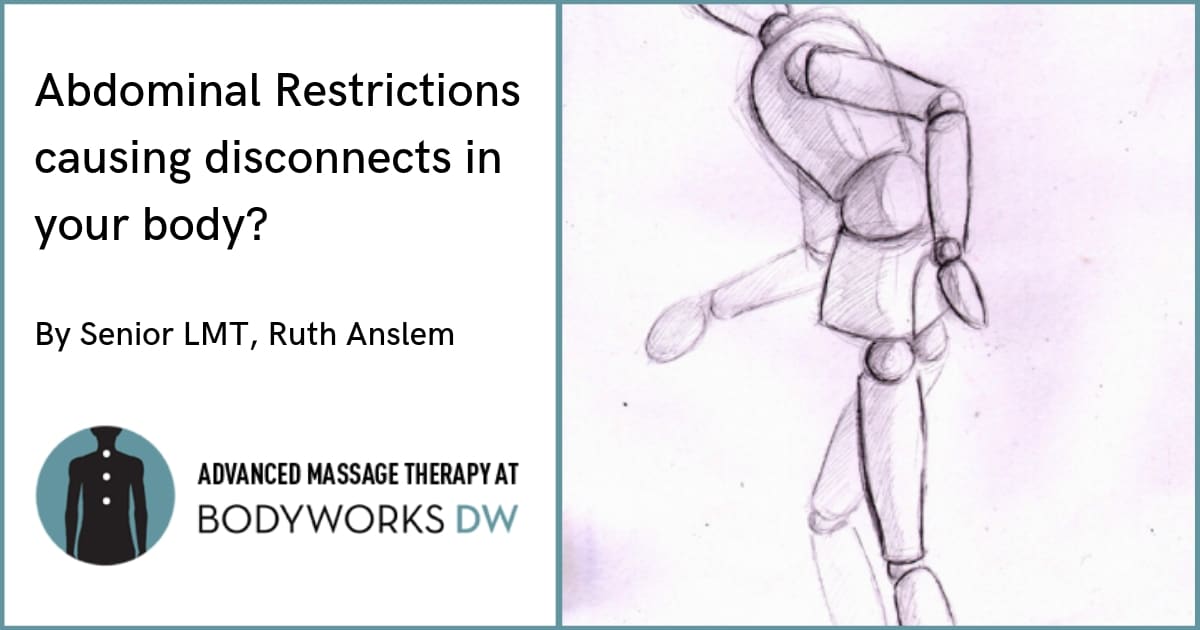YOUR CART
- No products in the cart.
Subtotal:
$0.00
BEST SELLING PRODUCTS
Home » News on Massage, Health and Wellness » Blog » The Benefits of Massage » LMT, Ruth Anselm talks about Massage Therapy for Abdominal Adhesions
Neck into shoulders + upper back, for sure. Although, you'd be surprised how many people need massage therapy for abdominal adhesions!
Asking questions helps me determine what area needs addressing first. Also, knowing the quality of your pain is important in understanding the likely causes of your pattern. It helps me decide how best to help! For many of you with shoulder and neck pain, the areas that need work are in the front of the body. Working on areas such as the pectorals/chest, abdominals + diaphragm, muscles of the front of the neck, jaw, and the scalp can help immensely. However, the actual area of your pain will always get some needed direct attention too 🙂
The "homework" I give depends on the individual. Some folks need to DO LESS! For those clients, I'll offer a restorative yoga pose to open the chest. I'll also ask them to incorporate more things into their week that make them feel relaxed. This includes taking walks in nature, baths, etcetera. Other clients need to actively stretch areas after warming up or add a little more blood flowing throughout the week. Taking more frequent breaks from desk work to roll shoulders, glance upward and breathe also go a long way!
Fascial restrictions in abdominals often disconnect upper body from lower body. For those who don't know, fascia is a sheet of connective tissue covering or binding together body structures (such as muscles). Most clients are surprised with the effectiveness of massage therapy for abdominal adhesions and will comment that they haven’t ever had it done... and didn’t realize they needed it.
Working the abdominal muscles and fascia can clue someone into how the upper & lower half of the body are connected. For many clients, they are often thought of as two separate areas that don’t affect one another. For instance, when abdominals are worked in relation to the front of the hips, it can lead to a fresher understanding of their body as a whole. To deepen this understanding, a therapist can work the abdominals and the front of the hips at the same time. The client can actually feel how one is pulling the other. For many who experience a “slouchy posture” the disconnect is from rib cage to abdominals. By opening up that relationship the client is able to feel more room for breath and ease in the chest. It's amazing how everything is interconnected, and how much the abdominals relate to massage therapy for the psoas muscle.
A few things inspired me to become a medical massage therapist. One of them being my own pain from injuries sustained from years of being an athlete/dancer. Another being the developing of pain management techniques learned through years of studying yoga. I also experimented quite a bit with rolling on balls and rollers to get relief. The criteria I had for selecting massage therapy as my next move were taking all my knowledge of the body and experience and directing it in one place. The desire being to impact others in a positive way and make it a career versus a job.
I had a client who experienced chronic pain since childhood. She had discomfort breathing, intense jaw pain, and an inability to sit or stand comfortably. Thankfully, we made incredible progress after a major shift in our first session! The intense jaw pain disappeared entirely, and the client gained the ability to sit cross legged as well as stand feeling even. The oldest of issues has taken repeated, regular sessions to help release the holding patterns that have crept in. This client's pain is under control & the work we've done has allowed great relief in activities of daily living.
The awareness and attention about the body that the client has gained is the most helpful and sustainable aspect of treatment. It helps them keep track and check in, noticing and changing patterns that contribute to the pain.
This site uses Akismet to reduce spam. Learn how your comment data is processed.


fantastic points altogether, you just received a brand
new reader.
Hmm it appears such as your website ate my first
comment (it absolutely was super long) therefore i guess I’ll just sum it up a
few things i had written and say, I’m thoroughly enjoying your site.
I also am an aspiring blog writer but I’m still new to everything.
Do you possess any tips and hints for novice blog writers?
I’d genuinely appreciate it.
Thanks! I think the best advice I can give is to try and express yourself in ways that teach and inform. For us, that means demystifying the body and how it works 🙂 What would that mean for you?
Very interesting article about what massages do to your different body parts. I never knew that working the abdominal muscles and fascia could do so much! I definitely think that regular massage treatments should be made as part of everyone’s regular routine.
Thanks!